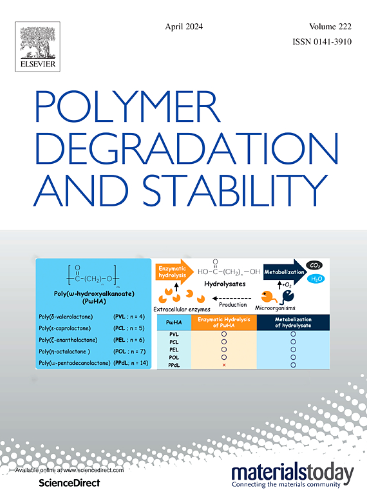Analysis of the hydrolysis behavior of poly(lactic acid) (PLA) and prediction of molecular weight distribution changes via the kinetic Monte Carlo method
IF 6.3
2区 化学
Q1 POLYMER SCIENCE
引用次数: 0
Abstract
Poly(lactic acid) (PLA) is a biobased and biodegradable plastic derived from natural resources. In this study, the degradation mechanism of PLA during hydrolysis was experimentally verified, and a computational strategy was constructed to predict its degradation behavior. The reaction rates and solid-state structure of PLA during hydrolysis were measured, and the hydrolysis behavior of the crystalline and amorphous phases was investigated. The results indicated that the molecular chains were randomly cleaved in the amorphous phase but were cleaved only on the folding surface of the lamellar crystals in the crystalline phase. Furthermore, the degradation behavior of amorphous and semicrystalline PLA during hydrolysis was modeled and simulated using the kinetic Monte Carlo method. The specific degradation behavior of the crystalline phase was described by considering the distribution of lamellar crystals and the dependence of the degradation rate on the molecular chain position. With this model, the molecular weight distribution and weight loss of PLA can be predicted. This study is the first to construct a degradation model based on a solid-state structure that can predict not only the average molecular weight but also the molecular weight distribution.

求助全文
约1分钟内获得全文
求助全文
来源期刊

Polymer Degradation and Stability
化学-高分子科学
CiteScore
10.10
自引率
10.20%
发文量
325
审稿时长
23 days
期刊介绍:
Polymer Degradation and Stability deals with the degradation reactions and their control which are a major preoccupation of practitioners of the many and diverse aspects of modern polymer technology.
Deteriorative reactions occur during processing, when polymers are subjected to heat, oxygen and mechanical stress, and during the useful life of the materials when oxygen and sunlight are the most important degradative agencies. In more specialised applications, degradation may be induced by high energy radiation, ozone, atmospheric pollutants, mechanical stress, biological action, hydrolysis and many other influences. The mechanisms of these reactions and stabilisation processes must be understood if the technology and application of polymers are to continue to advance. The reporting of investigations of this kind is therefore a major function of this journal.
However there are also new developments in polymer technology in which degradation processes find positive applications. For example, photodegradable plastics are now available, the recycling of polymeric products will become increasingly important, degradation and combustion studies are involved in the definition of the fire hazards which are associated with polymeric materials and the microelectronics industry is vitally dependent upon polymer degradation in the manufacture of its circuitry. Polymer properties may also be improved by processes like curing and grafting, the chemistry of which can be closely related to that which causes physical deterioration in other circumstances.
 求助内容:
求助内容: 应助结果提醒方式:
应助结果提醒方式:


